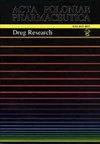响应面法在超声乳化胃肠外乳液研制中的应用
IF 0.4
4区 医学
Q4 PHARMACOLOGY & PHARMACY
引用次数: 0
摘要
摘要:静脉脂质乳剂是肠外营养的重要组成部分。长期服用这种疗法会导致肝功能障碍。由于肝衰竭的原因可能是脂质乳液液滴的大小,其减少会对患者的临床状况产生积极影响。本研究旨在开发和优化静脉注射脂质乳液的制备工艺,与市售制剂相比,该乳液的液滴尺寸更小。应用响应面法对超声乳化过程进行了优化。通过使用1.2%(w/w)的大豆磷脂和不同浓度的吐温80(2%、3%和4%(w/w))的组合来实现脂滴尺寸的减小。其他变量是超声振幅和超声时间。在优化过程中,开发了15种豆油基静脉脂质乳剂。所有制剂都具有适合静脉给药的物理化学性质,即MDD范围为119.1±0.6 nm至177.1±2.1 nm,PdI低于0219±0009。pH和渗透压分别为6.23±0.01至6.58±0和328±3至568±8mOsm/kg。Box-Behnken方法允许使用超声乳化优化静脉脂质乳液的制备。本文章由计算机程序翻译,如有差异,请以英文原文为准。
Application of response surface methodology in the development of parenteral emulsion using ultrasonic emulsification
Abstract: Intravenous lipid emulsion is a critical component of parenteral nutrition. Long-term administration of such therapy lead to liver dysfunction. As the cause of liver failure can be the size of lipid emulsion droplets, their reduction can positively affect the clinical condition of patients. This study aimed to develop and optimize the preparation process of intravenous lipid emulsions with reduced droplet size compared to commercially available formulations. The response surface methodology was applied to optimize the ultrasonic emulsification. The reduction of lipid droplet size was achieved by the use of a combination of 1.2% (w/w) soy phospholipids and various concentrations of Tween 80 (2, 3, and 4% (w/w)). The other variables were sonication amplitude and time of sonication. During the optimization process, fifteen soybeans oil-based intravenous lipid emulsions were developed. All formulations were characterized by the physicochemical properties appropriate for intravenous administration, i.e., MDD ranging from 119.1 ± 0.6 nm to 177.1 ± 2.1 nm, PdI below 0,219 ± 0,009. The pH and osmolarity ranged from 6.23 ± 0.01 to 6.58 ± 0 and from 328 ± 3 to 568 ± 8 mOsm/kg, respectively. The Box Behnken methodology allowed for optimizing the preparation of intravenous lipid emulsion using ultrasonic emulsification.
求助全文
通过发布文献求助,成功后即可免费获取论文全文。
去求助
来源期刊
CiteScore
0.80
自引率
0.00%
发文量
74
审稿时长
6-12 weeks
期刊介绍:
The international journal of the Polish Pharmaceutical Society is published in 6 issues a year. The journal offers Open Access publication of original research papers, short communications and reviews written in English, in all areas of pharmaceutical sciences. The following areas of pharmaceutical sciences are covered: Analysis, Biopharmacy, Drug Biochemistry, Drug Synthesis, Natural Drugs, Pharmaceutical Technology, Pharmacology and General.
A bimonthly appearing in English since 1994, which continues “Acta Poloniae Pharmaceutica”, whose first issue appeared in December 1937. The war halted the activity of the journal’s creators. Issuance of “Acta Poloniae Pharmaceutica” was resumed in 1947. From 1947 the journal appeared irregularly, initially as a quarterly, then a bimonthly. In the years 1963 – 1973 alongside the Polish version appeared the English edition of the journal. Starting from 1974 only works in English are published in the journal. Since 1995 the journal has been appearing very regularly in two-month intervals (six books a year). The journal publishes original works from all fields of pharmacy, summaries of postdoctoral dissertations and laboratory notes.

 求助内容:
求助内容: 应助结果提醒方式:
应助结果提醒方式:


